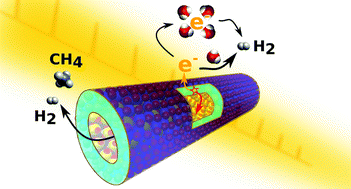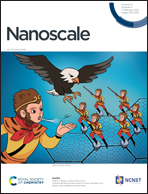Confined water radiolysis in aluminosilicate nanotubes: the importance of charge separation effects†
Abstract
Imogolite nanotubes are potentially promising co-photocatalysts because they are predicted to have curvature-induced, efficient electron–hole pair separation. This prediction has however not yet been experimentally proven. Here, we investigated the behavior upon irradiation of these inorganic nanotubes as a function of their water content to understand the fate of the generated electrons and holes. Two types of aluminosilicate nanotubes were studied: one was hydrophilic on its external and internal surfaces (IMO-OH) and the other had a hydrophobic internal cavity due to Si–CH3 bonds (IMO-CH3), with the external surface remaining hydrophilic. Picosecond pulse radiolysis experiments demonstrated that the electrons are efficiently driven outward. For imogolite samples with very few external water molecules (around 1% of the total mass), quasi-free electrons were formed. They were able to attach to a water molecule, generating a water radical anion, which ultimately led to dihydrogen. When more external water molecules were present, solvated electrons, precursors of dihydrogen, were formed. In contrast, holes moved towards the internal surface of the tubes. They mainly led to the formation of dihydrogen and of methane in irradiated IMO-CH3. The attachment of the quasi-free electron to water was a very efficient process and accounted for the high dihydrogen production at low relative humidity values. When the water content increased, electron solvation dominated over attachment to water molecules. Electron solvation led to dihydrogen production, albeit to a lesser extent than quasi-free electrons. Our experiments demonstrated the spontaneous curvature-induced charge separation in these inorganic nanotubes, making them very interesting potential co-photocatalysts.



 Please wait while we load your content...
Please wait while we load your content...